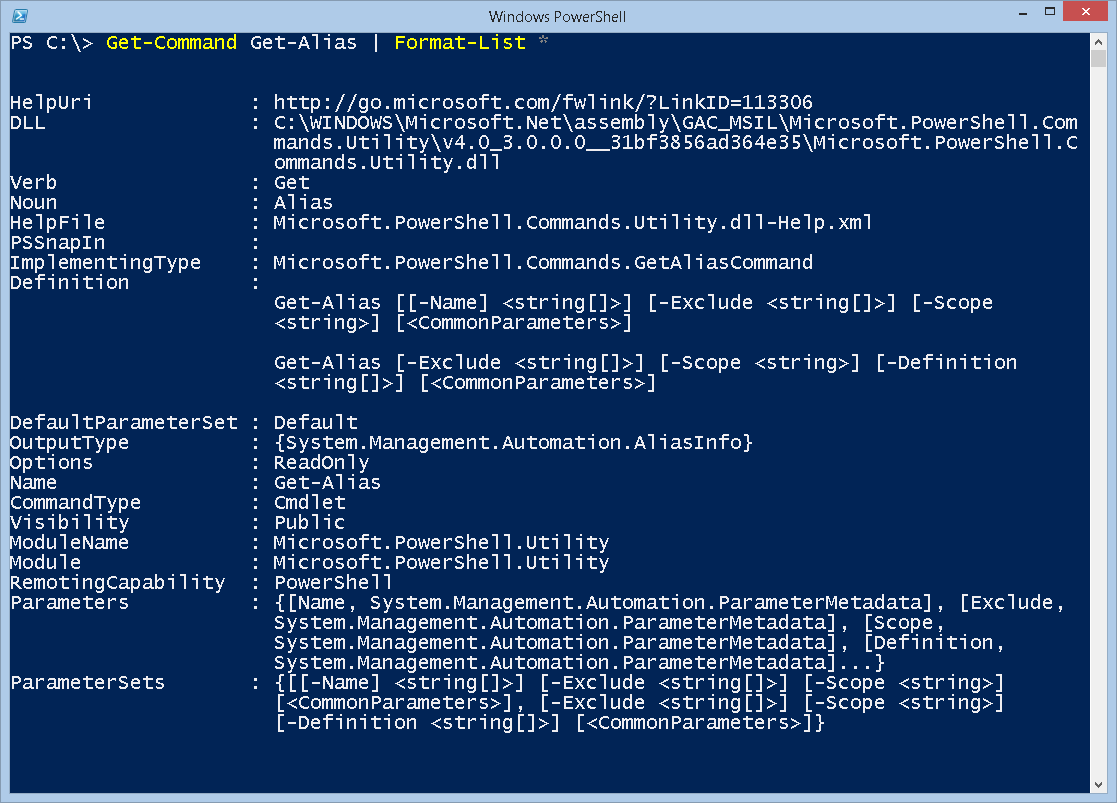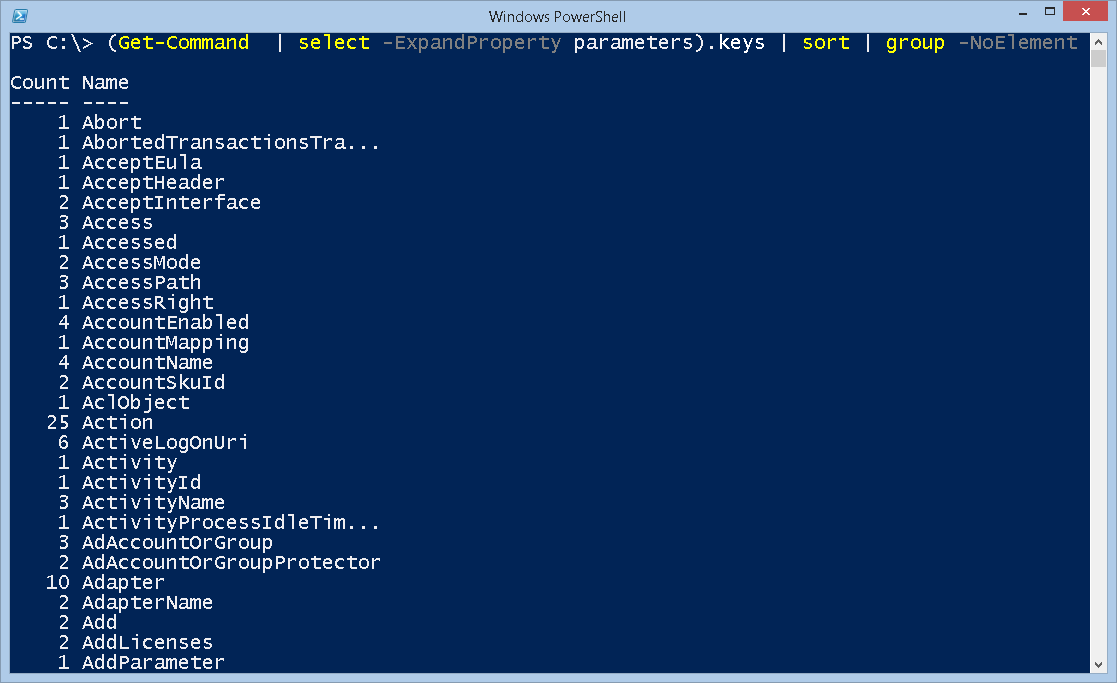Summary: Microsoft Scripting Guy, Ed Wilson, talks about finding the coolest Windows PowerShell parameter names.
Microsoft Scripting Guy, Ed Wilson, is here. This morning, my friend and colleague, Dr. Thomas Shinder, posted on Facebook that his favorite Windows PowerShell parameter name is –NoClobber. Interestingly enough, when I was writing my Windows PowerShell Step by Step book, one of the editors suggested that I change –NoClobber to something else. I had to tell her that I could not change it because it was actually part of the code.
So what are the parameters that are used by Windows PowerShell cmdlets and functions? To an extent, that depends on what modules are installed. For example, I have the MSOnline module installed, in addition to the PSCX module. So, the available parameters on my system could be a bit different than those on your system. Luckily, I can use Windows PowerShell to solve the problem.
The first thing I like to do is look at one cmdlet. If I can find the information I want with one cmdlet, I can easily abstract the methodology to all cmdlets and functions. For exploration, I will use the Get-Alias cmdlet. Obviously, I will be using the Get-Command cmdlet because it knows how to look at cmdlets. Here is my first foray:
PS C:\> Get-Command Get-Alias
CommandType Name ModuleName
———– —- ———-
Cmdlet Get-Alias Microsoft.PowerShel…
OK. That was not too exciting. So I decide to pipe the output to the Format-List cmdlet:
Get-Command Get-Alias | Format-List *
In the following image, I can see that there is lots of cool information that Get-Command obtains about the Get-Alias cmdlet:
I know that I am most interested in the Parameters property. I also can see from the previous image that there are objects stored in the Parameters property, so I know that I want to expand the property. To do this, I pipe the output to the Select-Object cmdlet (Select is an alias), and I use the –ExpandProperty parameter:
Get-Command Get-Alias | select -ExpandProperty parameters
The output from the command is shown here:
Obviously, I need the Key property. As shown here, when I select the Key property, nothing happens:
PS C:\> Get-Command Get-Alias | select -ExpandProperty parameters | select key
key
—
What has happened is that they renamed the property. I find this by piping the output to the Get-Member cmdlet (gm is an alias). I see the property is actually Keys.
PS C:\> Get-Command Get-Alias | select -ExpandProperty parameters | gm
TypeName: System.Collections.Generic.Dictionary`2[[System.String, mscorlib,
Version=4.0.0.0, Culture=neutral,
PublicKeyToken=b77a5c561934e089],[System.Management.Automation.ParameterMetadata,
System.Management.Automation, Version=3.0.0.0, Culture=neutral,
PublicKeyToken=31bf3856ad364e35]]
Name MemberType Definition
—- ———- ———-
Add Method void Add(string key, System.Management.Automat…
Clear Method void Clear(), void ICollection[KeyValuePair[st…
Contains Method bool ICollection[KeyValuePair[string,Parameter…
ContainsKey Method bool ContainsKey(string key), bool IDictionary…
ContainsValue Method bool ContainsValue(System.Management.Automatio…
CopyTo Method void ICollection[KeyValuePair[string,Parameter…
Equals Method bool Equals(System.Object obj)
GetEnumerator Method System.Collections.Generic.Dictionary`2+Enumer…
GetHashCode Method int GetHashCode()
GetObjectData Method void GetObjectData(System.Runtime.Serializatio…
GetType Method type GetType()
OnDeserialization Method void OnDeserialization(System.Object sender), …
Remove Method bool Remove(string key), bool IDictionary[stri…
ToString Method string ToString()
TryGetValue Method bool TryGetValue(string key, [ref] System.Mana…
Item ParameterizedProperty System.Management.Automation.ParameterMetadata…
Comparer Property System.Collections.Generic.IEqualityComparer[s…
Count Property int Count {get;}
IsFixedSize Property bool IsFixedSize {get;}
IsReadOnly Property bool IsReadOnly {get;}
IsSynchronized Property bool IsSynchronized {get;}
Keys Property System.Collections.Generic.Dictionary`2+KeyCol…
SyncRoot Property System.Object SyncRoot {get;}
Values Property System.Collections.Generic.Dictionary`2+ValueC…
In the following command, I choose the Keys property:
(Get-Command | select -ExpandProperty parameters).keys
As shown here, I receive a rather random output of parameter names:
I want to sort the parameter names, and I also want to group them. I do not want the elements, so I come up with the following command:
(Get-Command | select -ExpandProperty parameters).keys | sort | group –NoElement
The command and its associated output are shown here:
This gives me an alphabetical list of parameters. If I want to find the coolest parameter names, all I need to do is to scroll down the list. There are some pretty cool ones, but I think I like –XPATH…it is sort of like an XFiles, only different.
What cmdlet uses XPath as a parameter name? Easy. I use the Get-Command cmdlet to find it. Here is the command and output:
PS C:\> Get-Command -ParameterName xpath
CommandType Name ModuleName
———– —- ———-
Cmdlet Select-Xml Microsoft.PowerShel…
If I want to see which parameters are most popular, I simply add an additional sort. This command is shown here:
(Get-Command | select -ExpandProperty parameters).keys | sort | group –NoElement | sort count –Descending
The command and its associated output are shown in the following image:
I invite you to follow me on Twitter and Facebook. If you have any questions, send email to me at scripter@microsoft.com, or post your questions on the Official Scripting Guys Forum. See you tomorrow. Until then, peace.
Ed Wilson, Microsoft Scripting Guy






0 comments